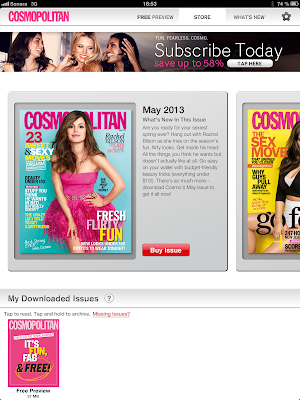One of the top keynotes at the conference was delivered by John Loughlin, Executive Vice President and General Manager, Hearst Magazines. Hearst Magazines is one of the world's largest publishers of monthly magazines, with 20 U.S. titles and close to 300 international editions. John Loughlin is positive about the future and says that the e-editions of magazines for Hearst are already a "multi-million" business, and a profitable one. He is "hugely bullish" on e-editions and says they are the single greatest opportunity publishers have to re-ignite growth, that is consumer and advertising revenue growth. In an overview of Hearst Magazines' tablet strategy he mentioned that the forecast is that nearly one third of the U.S. population i.e. 90 million people will be using a tablet by the end of this year. Hearst Magazines already have 900,000 digital subscribers and Cosmopolitan's e-edition is on the TOP3 consumer magazines with a digital circulation of 254,751 (up 37%) and a total paid circulation of +3 million as of 31.12.2013. An important point made by John Loughlin is that no content is for free, Hearst has had a clear strategy of charging for value-added services:
- "One of the first things we need to do is reset our value to the subscriber - charge fair market value for the magazine content. We are asked why the higher pricing by digital users?
- It's because they are first to the get the issue, they receive added content, and video and audio and interactivity. They get immediate satisfaction. They get to complete the impulse - to read and share and can even archive the content."
Grant Whitmore, Vice President, Digital at Hearst Magazines said in a separate interview that the online business of Cosmopolitan is growing fast with more than 10 million unique visitors per month and the target is set at 20 million by the end of 2014. The growth is boosted by traffic from smartphones, with up to 40% of traffic coming from mobile devices. Social is becoming even more important as to how audiences engage with the 'Cosmo' brand: Facebook, Twitter and Pinterest are the main channels here and more than 10% of traffic already comes through social channels. The biggest challenge is to handle the migration to smartphones, as the development of mobile advertising is still in its infancy, and mobile advertising is worth significantly less compared with tablets and online advertising.
Liz Schimel, Executive Vice President & Chief Digital Officer of Meredith Corporation stated that "Mobile disrupts Digital" as U.S. smartphone penetration is forecast to grow from 48% to 74% by 2016. Meredith's audiences comprise of 100 million women across every life stage. Meredith is investing into putting "content into context" and enhancing multi-screen experiences. Meredith's boasts 40 million unique visitors (mobile and online) in the genres of Food, Home, Moms and Lifestyle. "We have integrated e-commerce into our experience - our users want it. It gives us data about what excites our audience, then our editors can curate. We have found that ‘Content is Queen, Data is King' because we can analyze data and offer focused insights for our mobile shopping experience and mobile wallet. The data we collect leads to insights about ROI, which we can then give back to our advertisers."
Also many suppliers were present at Swipe 2.0, among those Adobe and Nokia together with Microsoft, promoting the new Windows-based Lumia phones as the "new way to read." On the notion of new ways to read, Paul Katz, Partner at Flipboard presented the app for reading on tablets and smartphones. Flipboard has already 50 million users according to Katz, and Flipboard 2.0 is all about co-creation of your own magazine inspired by your interests or life events. I have set up two magazines on the new platform, one about research related topics called 'EDGE & MEDIANOMICS' and the other called 'Digital & Mobile Life', curated bits and pieces from the digital ecosystem. The screen shot from my Flipboard is shown below, it is quite a convenient platform for reading content from different sources.
Last but not least, it should be noted that The Economist has now unbundled its subscriptions as of the April 3 issue. New price points have been set up accordingly. The pilot was started in the U.S. at the end of 2012 and has now been rolled out to the rest of the world, commented Susan Clark, MD, The Economist Digital & Group Marketing Director. "The rise of globalization helps our business, and the fact that English has become the second language for many people" boosts growth.
Readers of The Economist can now choose between digital only, print only or a full subscription across the platforms including mobile, online and print. The digital subscriber base is growing, however, many people still choose a bundle of digital and print subscription. "Many of us still lead multi-platofrm lives." In fact only 20% opted for the digital-only subscription in the U.S., where 60% of the audience of The Economist is today. Scandinavia is reportedly also a strong market with high readership and interest for global affairs and international business. It took The Economist, established in 1843, 160 years to reach 1 million subscribers, and 9 more years to go to 1.5 million. With a concept of expanding onto several platforms across the mobile ecosystem it may not take too long to reach 2 million subscribers? We shall see about this and I will continue reporting on developments in the Media and Publishing industries.





No comments:
Post a Comment
Have an idea or a comment - please give me your feedback!